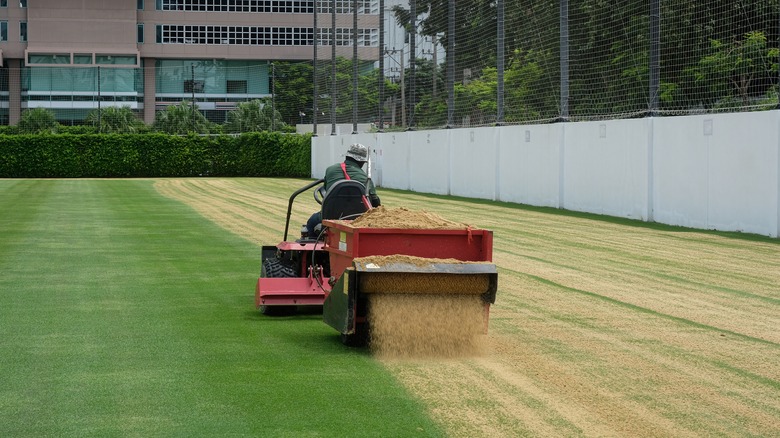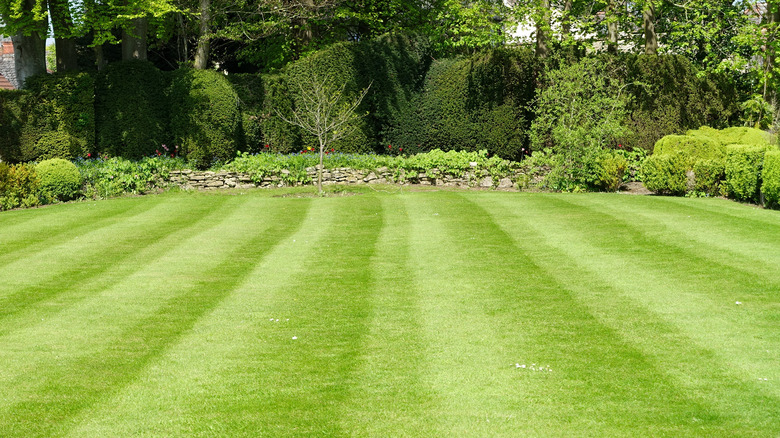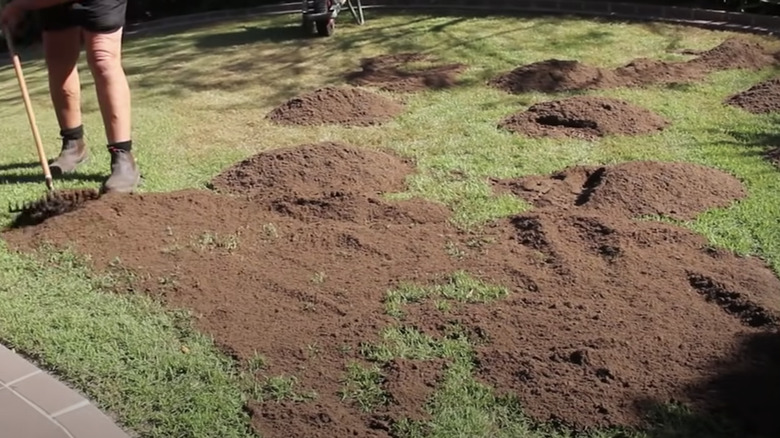Topdressing Your Lawn Is The Easiest Way To Get Better Looking Grass
Achieving the perfect lawn can take some time when you're starting from scratch. But, when you already have a well-established yard, it can be heartbreaking to see it go through a rough patch. If you notice dry areas, water them and let them get some sun. However, topdressing your lawn can improve any underlying issues affecting your grass's lushness. Top dressing is when you add a layer of soil, such as topsoil, sand, compost, etc., to your grass. Compost is the standard top dressing material used for all soil types. You can add sand to your lawn, but it's often used if you have hollows or use clay soils. The lawn's soil might lack the nutrients it needs to grow and maintain its health, so topdressing helps replenish the nutrients while improving the soil's quality.
Even if you have a good lawn routine where you water, mow, and trim it, sometimes it needs more care. It's ideal for topdressing your lawn when you notice the weeds growing faster than usual, yellow or bald spots, or squishy grass from when it was watered. The key to top dressing is only covering areas that desperately need it instead of blanketing the entire surface or removing your entire lawn and starting over. The process is easy and gives your yard many benefits.
Topdressing helps restore your lawn
If you spend most of your free time perfecting your lawn but don't see results, topdressing can give you a hand. We mentioned a few signs to look out for that topdressing will improve, but a significant factor to address is thatch build-up, when there are dead roots, stems, organic matter, and grass slightly below the surface of the lawn. In addition, the thatch layer cuts off the air and water supply the rest of the grass needs, so adding topdressing helps cut through the layer with the microorganisms it contains. The less thatch build-up your lawn has, the better it will look.
Preventing thatch build-up will also allow the microbes in the compost to evenly distribute the microbes your grass needs for the deeper roots to receive the nutrients they need. The compost has soil microbes that break down organic matter and helps improve the nitrogen required for the plant to get nutrients. Plus, they help balance the phosphorus, nitrogen, and carbon levels.
On the other hand, say your lawn has uneven areas; the dips or bumps can cause drainage issues that can lead to diseases. Topdressing the unleveled parts will prevent those problems and make it easier to mow your lawn. Also, if your grass tends to have a slow growth rate, adding grass seed under your topdressing will speed up seed germination allowing your grass to grow faster.
How to topdress your lawn
The topdressing process is straightforward; all you need are the right tools. Of course, if you don't have time to tend to your lawn, you can hire a professional, but the task can be done in less than a day. You'll need a power rake or aerator, topdressing material, wheelbarrow, lawn mower, grass seed, regular rake, garden fork, or shovel.
Breaking up the thatch layers around your lawn is key before adding topdressing. You want to ensure a clean surface where the nutrients can reach the plant's roots and soil. Using your aerator or power rake, remove as much of the thatch build-up as possible and throw out the dead grass, roots, and clumps you dragged into a bag. Next, mow the grass as short as possible and sprinkle the grass seed over the lawn. Then, add a ¼-inch layer of your topdressing over the lawn's surface with your shovel. Avoid dumping the topdressing in one area, you can wiggle the shovel on top of the grass, and it'll lightly add the compost. Once the topdressing is evenly spread out, rake it and water it to combine with the rest of the soil.
After the topdressing is set, you want to leave it alone. Avoid walking on it and mowing it for at least 10 days. You'll notice a difference in your lawn's water retention after a few weeks, and the vibrancy will come after a season or two.


